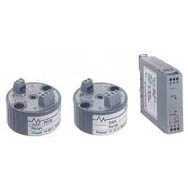Transmitters
- BMN-53 is a fully-scalable head-mount transmitter that is fully-adjustable.
- BMN-57 is a factory-scaled, fixed-range transmitter, that is also field-scalable.
- BMN-49 is a fully-scalable rail-mount transmitter that offers maximum flexibility.
If you need a high accuracy 2-wire transmitter at a price you can live with, these advanced, easy-to-use transmitters are available in three different models and accept various inputs. They offer ±0.1% accuracies at some of the lowest prices in the industry.
- A transmitter is a signal conditioner. It accepts a low-level signal from a sensor, a millivolt signal from a thermocouple, or a resistance signal from an RTD (Pt100), and provides an output signal that is directly proportional to the input signal. Most transmitters provide a current output signal (generally 4-20 mA or 0-20 mA signal) rather than a voltage output.
- Conversion to a current signal virtually eliminates any interference from line noise and allows accurate transmission over relatively long distances using ordinary uncompensated copper wire. The use of expensive thermocouple wire or extension wire is no longer necessary.
- Transmitters are available in both isolated and non-isolated versions. Isolated transmitters are used to provide galvanic separation between the sensor input and signal output. When grounded sensors are used or leakage to ground occurs with ungrounded thermocouples, isolated transmitters must be used.
- The BMN-53 is a fully-scalable head-mount transmitter that is fully-adjustable (via solderlink and precision 20-turn. potentiometers) from O °C/O °F to the full limit of the sensor.
- The BMN-57 is a factory-scaled, fixed-range transmitter with a unique difference: it is field scalable up to 100% of the factory-set range. (i.e. a 0 °C to 100 °C unit can be field-scaled anywhere between 0 °C to 100 °C/0 °F to 200 °F, 0 °C to 200 °C/0 °F to 400 °F). The Zero is also adjustable from -25 °C to +25 °C/-10 °F to 70 °F.
- The BMN-49 is a fully-scalable rail-mount transmitter that offers maximum flexibility. It also offers you the capability to shift the Zero point so your range doesn’t have to start at O °C/O °F. (For RTDs you can shift the Zero between -50 °C and 350 °C/-50 °C and 650 °F. For Thermocouples you can shift the Zero between -50 °C and 400 °C/O °C and 750 °F.)
- Aerospace, Military, and Commercial
- Automotive
- Foundries, Ferrous, and Non-ferrous
- Ceramics and Brick Kilns
- Petrochemical and Chemical Plants
- Co-energy
- Medical
- Food and Beverage
- Solar
Models and Options
Specialized Products
High-Temperature Insulated Wire ThermocouplesVulcan Electric offers a complete selection of products to meet your varied manufacturing needs.
New – Analog 2-Wire Head And Railmount TransmittersIf you need a high accuracy 2-wire transmitter at a price you can live with, these advanced, easy-to-use transmitters are available in three different models and accept MilliVolt, POOO, and Thermocouple (Types J, K, and T) inputs. They offer -O.1% accuracies at some of the lowest prices in the industry. The BMN-53 is a fully-scalable head-mount transmitter that is fully-adjustable via solder link and precision 20-turn. potentiometers from O-C/O-F to the full limit of the sensor. The BMN-57 is a factory-scaled, fixed-range transmitter with a unique difference. It is field scalable up to 100% of the factory-set range. (i.e. a 0 – to 100-C unit can be field-scaled anywhere between 0- to 100-C/0- to 200-F, 0- to 200-C/0- to 400-F). The Zero is also adjustable from -25- to +25-C/-10 to 70-F. The BMN-49 is a fully-scalable rail-mount transmitter that offers maximum flexibility. It also offers you the capability to shift the Zero point so your range doesn’t have to start at O-C/O-F. (For RTDs you can shift the Zero between -50- and 350-C/-50-C and 650-F. For Thermocouples you can shift the Zero between -50- and 400-C/O-C and 750-F.)
What is a Transmitter?Basically, a transmitter is a signal conditioner. It accepts a low-level signal from a sensor, a millivolt signal from a thermocouple, or a resistance signal from an RTD (Pt100), and provides an output signal that is directly proportional to the input signal. Most transmitters provide a current output signal (generally 4-20 mA or 0-20 mA signal) rather than a voltage output. Conversion to a current signal virtually eliminates any interference from line noise and allows accurate transmission over relatively long distances using ordinary uncompensated copper wire. The use of expensive thermocouple wire or extension wire is no longer necessary. Transmitters are available in both isolated and non-isolated versions. Isolated transmitters are used to provide galvanic separation between the sensor input and signal output. When grounded sensors are used or leakage to ground occurs with ungrounded thermocouples, isolated transmitters must be used. |

